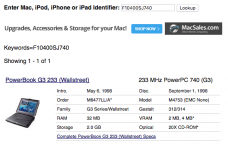There were a lot of less-publicized configuration options on some of the Macs coming out of Apple's factory.
The most notable, in my mind, was the stripped-down LC II without a hard drive. Schools were attracted to them because of the low price and ability to run Apple II software, which didn't require a hard drive. We had several of these at the first school I attended. They were used alongside a bunch of Pluses in a lab, so the startup disks and floppy copies of the software were already there. Using RAMDisk+, the system was loaded into memory, the active system disk switched to the RAM disk, and a floppy could be used without any swaps on these machines. (Conveniently, the color file for MECC programs fit alongside the program on a high density disk, as does the Kid Pix sounds file). The stripped LCs were also easy enough to upgrade once we moved on to larger programs; a hard drive could be popped in easily and inexpensively down the line. (We also did the LC III logic board upgrade on some of them).
Another great example is the no-CD LC 550. (I think the 575 also was available this way). This is an interesting machine in the fact it has a completely different front bezel, complete with an LC/Classic/SE style groove across the floppy slot. It looks more like a giant LC or Classic from that perspective. These seemed to be an education-only model; I only saw them in schools with one exception: a lady who bought one through her school while working as a secretary. I bought said LC 550 from her a few years ago. It's pretty well stripped down, but I believe she said it cost around $1300 when new. Considering the Trinitron inside, this was a pretty good deal when the LC III's price is considered alongside a Macintosh Color Display. (I really have come to like that particular 550 because of its obscurity and even got it re-capped).
I believe the Mac Classic could be ordered with an 80MB hard drive, but don't quote me on that one. I did see one in the wild at one point, but it could have been upgraded very early on in its life cycle.
There were dual-drive SE FDHDs out there as well. I would know; I own one, and it did come that way originally. (The original owner actually installed a hard drive on top of the second floppy).
I'm curious as to whether there were newer-style LC IIIs available to schools as 25MHz machines at one point. I had one of these and still feel bad about selling it to a guy as an LCIII+ based on the case. I know now to check every III, especially since someone found a 16MHz variety not long ago.







